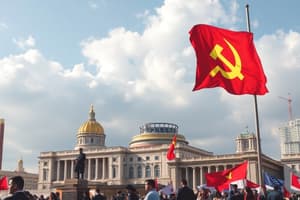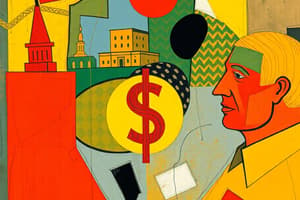Podcast
Questions and Answers
What economic condition is typically associated with very high unemployment?
What economic condition is typically associated with very high unemployment?
- Inflation
- Hyperinflation
- Deflation (correct)
- Disinflation
Which of the following best describes hyperinflation?
Which of the following best describes hyperinflation?
- A gradual increase in average prices
- A period of stable consumer prices
- An average monthly inflation rate below 1 percent
- An average monthly inflation rate of more than 50 percent (correct)
Which of these tools does the government primarily use to assess inflation?
Which of these tools does the government primarily use to assess inflation?
- Gross Domestic Product (GDP) and Personal Consumption Expenditures (PCE)
- National Income and Net Exports
- Consumer Price Index (CPI) and Producer Price Index (PPI) (correct)
- Trade Balance and Employment Rate
What is the goal of increasing productivity in an economy?
What is the goal of increasing productivity in an economy?
Which province in Canada is expected to lead economic growth in the near term?
Which province in Canada is expected to lead economic growth in the near term?
What is the primary economic philosophy that Karl Marx advocated in his writings?
What is the primary economic philosophy that Karl Marx advocated in his writings?
Which of the following is NOT a characteristic of communist systems as described?
Which of the following is NOT a characteristic of communist systems as described?
How do socialist economies generally redistribute wealth?
How do socialist economies generally redistribute wealth?
What was a common outcome in countries that adopted communism in the 1900s?
What was a common outcome in countries that adopted communism in the 1900s?
Which sector is primarily suggested for government ownership in socialist economies?
Which sector is primarily suggested for government ownership in socialist economies?
What effect do austerity measures have on public benefits in an economy?
What effect do austerity measures have on public benefits in an economy?
Which of the following best describes the economic outcome in Western European socialist economies in recent years?
Which of the following best describes the economic outcome in Western European socialist economies in recent years?
What common problem arises in economies with government-operated enterprises, as noted in the discussion on socialism?
What common problem arises in economies with government-operated enterprises, as noted in the discussion on socialism?
What does GDP measure in an economy?
What does GDP measure in an economy?
Which type of unemployment reflects the freedom to change jobs?
Which type of unemployment reflects the freedom to change jobs?
During which phase of the business cycle does the economy experience rising unemployment?
During which phase of the business cycle does the economy experience rising unemployment?
What is the average unemployment rate in Canada from 1966 to 2015?
What is the average unemployment rate in Canada from 1966 to 2015?
What economic event is declared when GDP decreases for two consecutive quarters?
What economic event is declared when GDP decreases for two consecutive quarters?
What is the term used for the process of converting government-owned businesses to private ownership?
What is the term used for the process of converting government-owned businesses to private ownership?
Which type of unemployment is characterized by job loss related to the time of year?
Which type of unemployment is characterized by job loss related to the time of year?
Which of the following best describes a depression?
Which of the following best describes a depression?
What is typically included in GDP calculations?
What is typically included in GDP calculations?
What describes the lowest point of an economic contraction?
What describes the lowest point of an economic contraction?
What major factor has contributed to the slowdown of economies according to the content?
What major factor has contributed to the slowdown of economies according to the content?
What system is defined as an economic system where the government owns key enterprises for public welfare?
What system is defined as an economic system where the government owns key enterprises for public welfare?
Which of the following countries has seen significant free market reforms in the past two decades?
Which of the following countries has seen significant free market reforms in the past two decades?
What is one consequence noted from economic restructuring towards market economies?
What is one consequence noted from economic restructuring towards market economies?
Why do pure market economies fail in meeting citizens' needs?
Why do pure market economies fail in meeting citizens' needs?
What aspect of economic performance is not captured by a single measure?
What aspect of economic performance is not captured by a single measure?
How is Real GDP defined?
How is Real GDP defined?
Which of the following is a characteristic of Canada’s economy as described in the content?
Which of the following is a characteristic of Canada’s economy as described in the content?
What can be said regarding the global trend of economies over the past 30 years?
What can be said regarding the global trend of economies over the past 30 years?
What was a notable effect of social media on government actions in Macheng?
What was a notable effect of social media on government actions in Macheng?
Flashcards
Socialism
Socialism
An economic system where key businesses affecting public wellbeing, like utilities and healthcare, are owned and run by the government.
Communism
Communism
A philosophy where the government directs the economy, owning virtually all businesses. It aims to improve worker conditions but has a history of authoritarianism and shortages.
Austerity Measures
Austerity Measures
Measures taken by governments to reduce spending and debt, often by cutting public benefits.
Work Incentive
Work Incentive
Signup and view all the flashcards
Free Market
Free Market
Signup and view all the flashcards
Free Market Mechanism
Free Market Mechanism
Signup and view all the flashcards
Supply and Demand
Supply and Demand
Signup and view all the flashcards
Individual Choice
Individual Choice
Signup and view all the flashcards
Mixed Economy
Mixed Economy
Signup and view all the flashcards
Gross Domestic Product (GDP)
Gross Domestic Product (GDP)
Signup and view all the flashcards
Privatization
Privatization
Signup and view all the flashcards
Business Cycle
Business Cycle
Signup and view all the flashcards
Inflation
Inflation
Signup and view all the flashcards
Productivity
Productivity
Signup and view all the flashcards
Employment Level
Employment Level
Signup and view all the flashcards
Expansion
Expansion
Signup and view all the flashcards
Hyperinflation
Hyperinflation
Signup and view all the flashcards
Disinflation
Disinflation
Signup and view all the flashcards
What is GDP?
What is GDP?
Signup and view all the flashcards
What is contraction?
What is contraction?
Signup and view all the flashcards
What is the unemployment rate?
What is the unemployment rate?
Signup and view all the flashcards
What is the business cycle?
What is the business cycle?
Signup and view all the flashcards
What is privatization?
What is privatization?
Signup and view all the flashcards
What are mixed economies?
What are mixed economies?
Signup and view all the flashcards
What is a depression?
What is a depression?
Signup and view all the flashcards
What is recovery?
What is recovery?
Signup and view all the flashcards
What is a recession?
What is a recession?
Signup and view all the flashcards
What is seasonal unemployment?
What is seasonal unemployment?
Signup and view all the flashcards
Study Notes
Work Incentives and Economic Systems
- Work incentives influence entrepreneurial migration and worker motivation, affecting economic decisions.
- Austerity measures, reducing public benefits, can impact economic systems.
Communism
- Communism is a political and economic system advocating public ownership of enterprises, controlled by a central government.
- Karl Marx, a political philosopher, developed the communist concept in his book, Das Kapital (1867).
- Communism aims to improve workers' conditions at the expense of the wealthy.
- Communist countries, such as the former Soviet Union, China, Cuba, North Korea, and Vietnam historically not achieved economic prosperity.
- Authoritarian governments, suppressing individual freedoms, often characterized communist regimes.
- Shortages and surpluses were common due to the absence of a free market.
- Corruption plagued various levels of government.
- Most communist regimes in Europe collapsed in the late 1980s, transitioning to democracy and free markets.
Socialism
- Socialism is an economic system where the government owns and controls key industries affecting public welfare (e.g., utilities, healthcare).
- While aiming for public good, socialist enterprises often face inefficiency and corruption.
- High taxes in socialist economies aim to distribute wealth evenly, funding public services (e.g., childcare, education, healthcare) which might be privately funded elsewhere.
- Western European countries such as Sweden, Germany, and the UK had developed powerful socialist economies in the 20th century, but later experiences slower growth.
- High taxes and generous social programs may discourage economic growth.
Mixed Economies
- Pure market or planned economies are rare; most countries have mixed economies.
- Mixed economies represent a balance between planned and market systems.
- Even market-oriented economies like Canada retain government control or regulation of various sectors (e.g., healthcare, education, military).
- Many countries globally have shifted toward market-based economic systems over recent decades.
- Privatization, reduced government restrictions, and reformed tax incentives have spurred economic growth in some areas.
- Economic restructuring has led to social unrest in some nations.
- Countries moving toward market systems (small and large) have experienced rising living standards for many.
Evaluating Economic Performance
- No single indicator captures all economic performance aspects; a combination offers greater comprehension.
- Metrics like GDP, employment levels, business cycles, inflation rates, and productivity are vital for evaluation.
Gross Domestic Product (GDP)
- Real GDP measures the value of final goods and services produced within a nation's borders, adjusted for inflation.
- GDP includes domestic production regardless of ownership (e.g., foreign-owned car plants).
- GDP doesn't include illegal activities or unreported output, potentially understating the true economic figure.
- Canada's GDP was approximately USD$1.79 trillion in 2014, a little lower than the record-high $1.84 trillion in 2013.
Employment Level
- Employment levels, reflected in unemployment rates, indicate economic health.
- Unemployment includes individuals of employment age actively seeking work but not employed.
- Canada's average unemployment rate is approximately 7.7% between 1966 and 2015.
- Unemployment can be either positive (frictional unemployment, allowing for job changes) or negative (structural).
- Structural unemployment arises when economic needs no longer match worker skills (e.g., manufacturing in Canada).
- Other unemployment types include cyclical (during recessions) and seasonal.
The Business Cycle
- The business cycle describes an economy's recurrent contractions and expansions.
- Phases differ in length and intensity each time.
- Contraction involves economic downturn marked by higher unemployment and decreased business production.
- A recession is officially declared when GDP declines consecutively for two quarters.
- Depressions are severe, long-lasting recessions.
- Recovery is a period of rising economic growth and employment.
- Expansion involves robust economic growth and high employment.
- The peak of an expansion is the height of economic activity.
Price Levels
- Inflation signifies rising average prices.
- Moderate inflation shows a healthy economy.
- Hyperinflation, characterized by monthly price increases over 50%, can be problematic.
- Disinflation is a period of decreasing inflation rates.
- Deflation is falling prices; often indicates an economic downturn and high unemployment (e.g., Great Depression).
- Canada's inflation rate ranges from 1 to 3% recently, measured by the Consumer Price Index (CPI).
- The PPI (Producer Price Index) measures wholesale prices, potentially predicting consumer inflation.
Productivity
- Productivity measures the relationship between output (goods and services) and resources used to produce them.
- Higher productivity typically correlates with stronger GDP growth and vice versa.
- Technology has driven productivity gains in Canada.
Specific Case Study (China)
- Chinese students face challenges lacking adequate school resources.
- Social media outrage highlights government inaction and social inequality.
- Public discussion about resource disparity and government legitimacy arises.
Studying That Suits You
Use AI to generate personalized quizzes and flashcards to suit your learning preferences.




